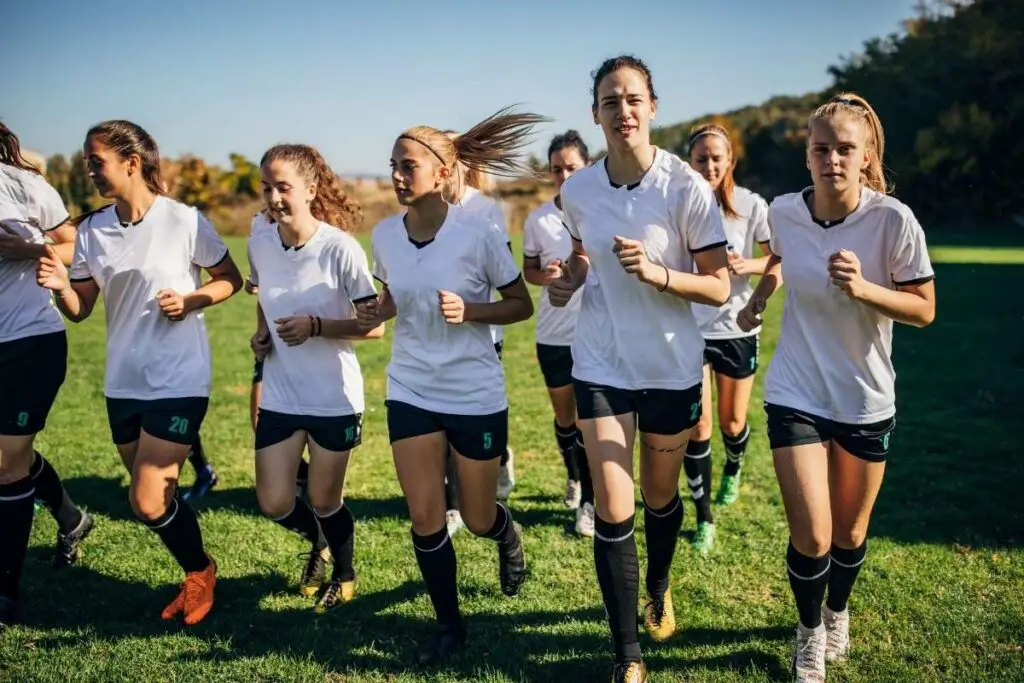Billions of people worldwide are fans of soccer (football), with a high percentage of them playing the game themselves. Cardiovascular conditioning and physical training are the two main aspects of getting in shape to play soccer. Below, we will dive into the various facets of getting in soccer shape.
How to Get in Shape for Soccer
The main aspects of getting in shape for soccer include cardiovascular and physical training.
Cardiovascular training involves doing aerobic exercises, such as running, to strengthen the:
- heart
- lungs
- vasculature
This aspect trains the player’s stamina and how long they can play the game at an efficient level. Physical training includes anaerobic exercise (weight training) and learning the different physical skills needed to play the game.
Weight training boils down to weightlifting utilizing an optimal regimen for soccer. Physical training includes practicing the skills needed to proficiently play the game:
- kicking
- ball-handling
- heading, etc.
These skills are generally acquired and maintained through drills designed to enhance muscle memory and agility.
How Long Does It Take to Get in Shape for Soccer?

Getting into soccer shape is highly individualized and varies from player to player. Factors to consider include: what skill level is being played at, player age, and overall relative health. That said, the average person in decent health could likely get into soccer shape within four to six months. Getting into soccer shape in this timeframe would require a commitment from the individual, and they would need to be training 4-5 days per week. Again, this is a highly variable concept.
If you are looking to the best soccer ball, check out our recommended soccer balls below:
[amazon table=”144″]
How Do I Get a Good Body for Soccer?
There is no one-size-fits-all body type for soccer success. It is important to have a strong lower body, as the game is played on your feet at a high pace. The body parts that need conditioning for soccer include your quads, hip flexors, glutes, and calves. These muscles are built during both cardiovascular and weight training.
They are also honed during calisthenics and skill training. There are many different training regimens out there regarding getting fit for soccer. It is recommended that you start with aerobic conditioning as soccer is a continuous movement sport and you must have stamina and be used to moving constantly.
Once you have built up your stamina and your legs are used to running, you can start incorporating weight training with a focus on building functional strength without adding too much bulk.
How Do You Get in Shape for Soccer Tryouts?
Getting into shape for soccer tryouts, again, is quite individualized. What type of tryout is it? Are you already in some sort of good shape? How long do you have until tryouts? These are all questions a player must ask themself regarding the issue.
Generally, a good regimen starts with a proper aerobic exercise program, such as developing a running schedule. This will help you get into proper shape for soccer tryouts.
This regimen should be designed to “ramp up” each week or so, thereby gradually increasing the player’s stamina.

Another crucial aspect of any workout program includes a specialized weight training regimen. There are hundreds of programs out there with proven results, so do some research before just jumping in. Lastly, any training regimen needs actual time to practice the physical skills needed to excel at the game. This includes drills to practice kicking, dribbling, tackling, etc. It also includes time spent playing the game, both against teammates during practice and foes in live competition.
How to Get in Shape for Soccer Matches in 1-2 weeks
There are no shortcuts when it comes to getting into soccer shape. Additionally, getting into match shape in such a small amount of time is highly dependent on the shape you are currently in.
Getting into Match Shape if You Are Already in Decent Shape
Assuming one has put in the time beforehand, we will discuss actions one can take when one week out from competition. Eating right, getting regular, good sleep, and avoiding alcohol and other negative foods are important parts of the week before game time.
Also, maintaining one’s regular workout routine is paramount to success. It has been shown that reducing the intensity of the workouts approximately 48 hours before competition can be beneficial. This will allow you to be both rested and fit for your soccer match.
Getting into Match Shape if You Are Not Currently in Shape
Running. You need to start running and stretching routine asap. Given you are not currently in shape, you need to focus on two things:
- Building up cardio/stamina via running
- Stretching to help prevent pulling muscles not used to working at intensity
You may want to try to overdo it due to the lack of time before your match. This would be a mistake and will likely lead to injury. Focus on building up your running incrementally each day. Your feet and legs need to get used to extended running and you need to build up your stamina.
Recommend Shin Guards
[amazon table=”159″]
What Conditioning Program or Exercises Should I Do for Soccer?
There are hundreds of soccer conditioning/training programs out there, each with its own benefits and drawbacks. When looking for an optimum program, players should be focused on a regimen that changes up the workouts daily. This ensures that all parts of the body are worked on and all skills are sharpened.
Each day should include exercise/training in cardiovascular (aerobic) exercise, weight training and lifting (anaerobic), and physical drills designed to work on building the skills of the game. The video linked above has an excellent 20 minute workout that covers the key aspects of a comprehensive soccer workout. Proper nutrition and sleep habits are also a must.
Enclosed below is an exercise routine I recommend to build soccer fitness:
What Foods Should Soccer Players Avoid?
When it comes to food and drink that soccer players should avoid, there are several culprits that should be used sparingly, if at all. First on the list is alcohol. Alcohol is a depressant and saps your energy while leaving you feeling sluggish, especially during the hangover period. Another food to avoid is anything with saturated fat, an artificial fat found in many fried and processed foods. Third, players should avoid high-sugar energy drinks and sodas. These beverages seem like they can provide you with hours of energy, but all they really do is give you a quick sugar rush, with a subsequent crash afterward.
Here is a list of foods for soccer players to avoid and what foods you should eat instead:
What Foods Should Soccer Players Eat?
Conversely, there are foods that all soccer players should eat on a regular basis. These include fresh fruits and vegetables, foods containing unsaturated fats (fish, nuts, olive oil), fresh-pressed juices, and the occasional cup of coffee. All of these foods promote the body’s healthy use of natural sugars for energy, thereby giving the athlete all the energy they need to perform at peak levels.
